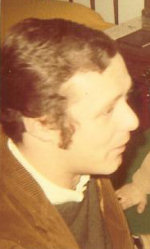WDRQ HEARD HERE 24/7 ON MOTOR CITY RADIO FLASHBACKS
From the MCRFB AIRCHECKS archive featuring: WDRQ-FM (’72) w/ JOEY RYAN
![]()
 From the MCRFB news archive: 1970
From the MCRFB news archive: 1970
Station Air Talents Control Shows: Avails Audience Appeal via Telephone
DETROIT — Personal contact blended with a consistent music policy directed at adults is paying off for WHFI-FM, a stereo station. Tom Danley, in slightly over a year at the station, has taken it from billings of only $20,000 per year to approximately $250,000 this fiscal year and by next year expects to be far above those figures.

The first thing Danley did upon arriving at the station, which is located in the suburbs of Detroit in Birmingham, was raid-local AM stations for top-flight personalities. Then he gave them not only control of their show, but made them available to the listeners not only through radio, but through the telephone.
There are three direct phone lines into the studio “and the phones are constantly ringing . . . sometimes all three at once,” said Danley.
He confessed that once a phone call received by evening Don Alcorn was a wrong number. “Turned out she’d never heard of WHFI-FM or Alcorn and thought she was kidding her when he told her she was on the air. He convinced her into getting an FM radio and then helped her dial it to 94.7, chatting with her all the time. ‘Is that me,’ she yelled, after she got the station. I think she’s now a confirmed WHFI-FM fan.”
Danley said it would be difficult to find at least 60 seconds when those phones are not ringing . . . even on the all-night show. The air personalities — which includes music director Marc Avery, Lee Alan, Joey Ryan, program director Don Zee, Alcorn, and all-night man Bob Bereten — can talk when they want to . . . segue when they want to . . . “they’re in complete control of their show,” said Danley.
The air personalities operate from a playlist of about 100 records, plus a huge volume of albums from which oldies are taken. The oldies are records that were previous Top 40 hits which fit the uptempo easy-listening format of the station. The only restriction is that is that no more than three oldies can be played per show, although the air personality doesn’t have to play any if he doesn’t want to.
Chain Planned
WHFI-FM is on an upgrading drive and the company plans to grow into a chain of stations . . . all of them strictly FM. The station is building a new station and will move into completely new facilities in October.
“FM radio has arrived,” said Danley, “especially in regards to being a profit vehicle for advertisers. I have never received so many call-ins from potential clients . . . listeners who operates businesses and want us to come out and talk to them about an advertising schedule on the station. And I’ve worked for some major stations.”
To spur further call-ins, WHFI-FM has a series of brief promotions on the air asking: “Mr. Businessman, are you listening to WHFI right now? So are a lot of other people.” WHFI-FM is also very promotional-minded off the air. “I tell potential clients there’s no such thing as ‘one’ place to advertise. It’s a valid rule for us to follow, too. So, we’re involved in everything, including bumper stickers.”
The music policy that Danley installed when he first came to the station in August, 1969, was consistency.” Previously, the music format was in the right direction (Tom Jones and Pet Clark), he felt, but occasionally heavier records were thrown in. Danley set a more consistent policy on record. “The sound is hard to describe, but you can more or less tell when you turn on the station now.” END
(Information and news source: Billboard; October 3, 1970).
![]()